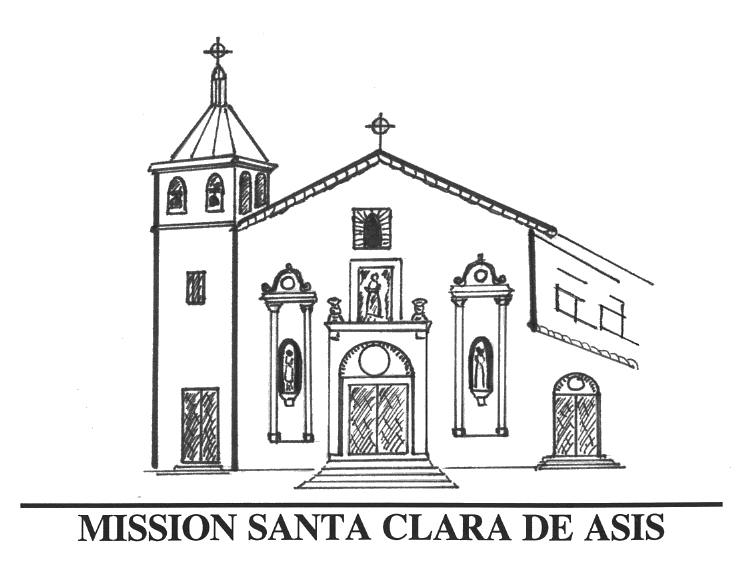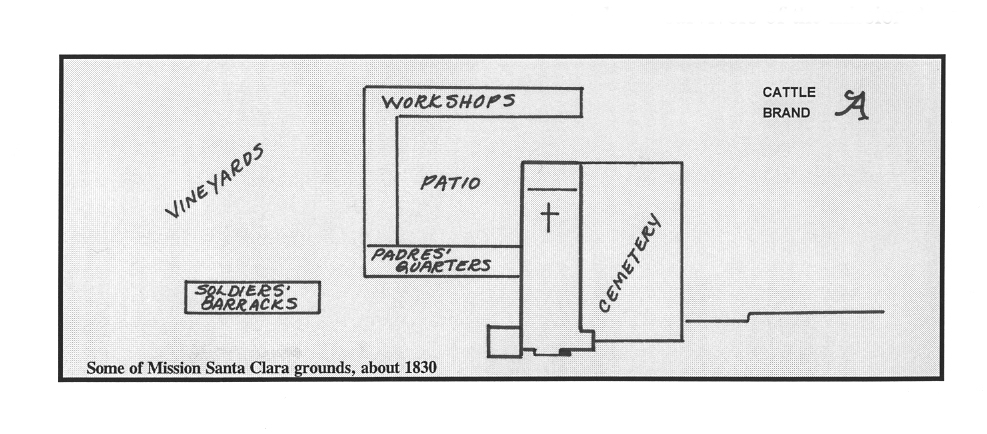| ||||
|
| ||||
|
MISSION
SANTA CLARA DE ASIS
Lexington Street & The Alameda
(Box 3217)
Santa
Clara, CA
95053
Established: January 12, 1777
By: Father Junípero Serra, Franciscan missionary, President of the missions.
Order: 8th of the 21 missions.
Location: 40 miles SE of San Francisco at the southern end of San Francisco Bay, near a stream called Río de Nuestra Señora de Guadalupe.
Named: For St. Clare of Assisi (1193-1253), founder of an order of nuns called the Poor Clares, similar to the Franciscans.
California Historical Landmark No. 338
DESIGN OF THE MISSION
Church: The fifth and most important church was built in 1825 of adobe bricks, 100 feet long, 44 feet wide, 25 feet high. Tile roof.
Style: Simple architecture was richly ornamented with paintings, both inside and out. Professional artist Agustín Dávila came from Mexico to design and oversee the painting. On the redwood slabs that formed the ceiling he depicted hosts of angels and saints. Designs painted to look like pillars and statues flanked the entrance. Colors were brilliant reds, yellows, and blues, dyes made from local minerals mixed with juice from the maguey cactus. Dávila directed the work of native artisans who did the painting.
Walls: Wider at the bottom, narrowing to two feet thick at the top.
Bell Tower: A square tower built to the left of the entrance. Two of the three bells were gifts of the King of Spain in 1799.
Mission Compound: Buildings that formed the quadrangle served as living quarters for priests and soldiers, kitchens, a guardhouse, and work-shops. The Costanoan Indians at Santa Clara were good spinners and weavers, and their work was known throughout the chain of missions. They also made candles, and produced wine and brandy. This mission's greatest mark of prosperity was in the number of converts; over 1,200 native workers lived at the mission.
Mission Grounds: Fields and orchards produced peaches, pears, figs, grapes and grain. Nearby ranches had 5,000 head of cattle and 12,000 sheep, adding to the prosperity of the mission. A grand avenue called The Alameda, lined with a triple row of willow trees, connected the mission with the growing Pueblo (town) de San José de Guadalupe. The mission built the attractive avenue in an attempt to improve relationships between the pueblo and the mission.

EARLY HISTORY
1776 Site chosen by Juan Bautista de Anza, at the same time as he chose the Mission San Francisco site.
1777 Cross planted by Father Tomás de la Peña, at the direction of Father Serra. Church built of logs.
1779 Second log church constructed on higher ground, to avoid flooding.
1781 Site again shifted to higher ground; Father Serra laid cornerstone for new church.
1784 Adobe church completed, said to be the most beautiful church in existence at that time, designed by Father Murguía who also supervised the construction but died just before the dedication. Father Serra was present at the dedication on May 15.
1794 Father Magín Catalá, called The Holy Man of Santa Clara, began his 36 years at the mission.
1812 Earthquake weakened the walls.
1818 Earthquake destroyed the church; new church built but that too was destroyed.
1825 Fifth (and longest lasting) church completed and dedicated on August 11.
1836 Mission secularized, lands taken from the Franciscans. Building continued to be used as a parish church.
1839 Bell tower, weakened by storms, replaced with a wooden tower.
1851 Authority for the church transferred from the Franciscans to the Jesuits, who founded a college there which became Santa Clara University.
MISSION SANTA CLARA TODAY
The natural disasters that plagued the early mission church continued into this century. As a part of Santa Clara University, the church was remodeled several times. Each time some of the original design was lost. The adobe walls were replaced with wood walls; a second bell tower was built on the opposite side of the building; the roof was widened.
In 1926 a fire destroyed the church, erasing all of the changes. Students at the University tried to save the important furnishings from the fire. One of the bells was melted by the heat; a second was cracked. But the one bell that survived (a gift of the Spanish king) was hung from a tree and rang that night at 8:30 just as it had every night since 1799. Several years later, King Alfonso XIII of Spain sent a new bell. The two damaged bells were recast, and when the bell tower was rebuilt, it had four bells.
In 1929 the church was reconstructed in what is called "a modern interpretation in stucco and concrete" of the 1825 church.
12,000 roof tiles salvaged from earlier missions were used in the new church, which is larger than the original. Replicas of the ceiling paintings have been done. The exterior designs have been replaced in stone relief (carvings) rather than the original painted form. Over the main entrance is a statue of St. Clare, flanked by statues of St. John the Baptist and St. Francis, all carved in pearwood. The interior of the church has been redecorated in Victorian style, retaining only a little of the mission atmosphere. There are some original statues inside.
The cross that was erected in 1777 stands (in a protective casing) across from the church entrance. The few adobe walls of the quadrangle remaining after the 1926 fire have been restored. The old church cemetery is now the Mission Rose Garden. Many of the plants on the University grounds are survivors of the mission days.
